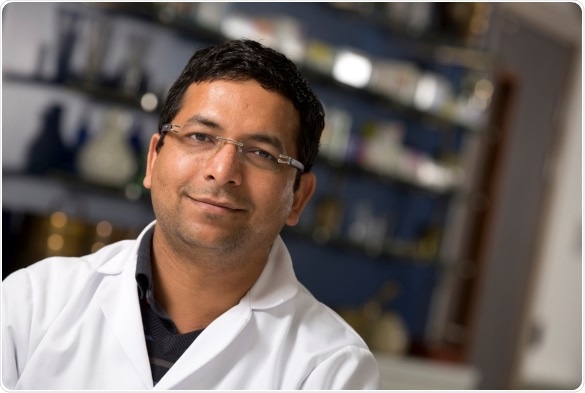A team of researchers from the University of Liverpool and the University of Utrecht has reached one step closer in its quest for developing a feasible teixobactin-based drug. Teixobactin is a new group of powerful natural antibiotic that has the ability to destroy superbugs.

Dr Ishwar Singh, University of Liverpool. Image Credit: University of Liverpool
Recently published in the Nature Communications journal, the study offers a new, fundamental understanding of how teixobactins destroy microorganisms, including the finding of a novel killing mechanism that may help in the development of enhanced drugs based on teixobactin.
When teixobactin was discovered in 2015, it was touted as a “game changer” because of its potential to destroy multi-drug-resistant bacterial pathogens, like MRSA, without building up resistance. If teixobactin is made appropriate for humans, it would represent the first new group of antibiotic drug to be ever developed in three decades.
Over the past six years, Dr Ishwar Singh, a specialist in Antimicrobial Drug Discovery and Development and Medicinal Chemistry at the Centre of Excellence in Infectious Diseases Research in the University of Liverpool, has headed a groundbreaking study to develop feasible drugs based on teixobactin.
Dr Singh’s research team was the world’s first to effectively produce streamlined synthetic forms of teixobactins, which can be effectively used for treating mice affected by bacterial infections.
We know that the therapeutic potential of simplified synthetic teixobactins is immense, and our ultimate goal is to have a number of viable drugs from our synthetic teixobactin platform which can be used as a last line of defence against superbugs to save lives.”
Dr Ishwar Singh, Expert in Antimicrobial Drug Discovery and Development and Medicinal Chemistry, Centre of Excellence in Infectious Diseases Research, University of Liverpool
For the first time, the researchers used microscopy and high-resolution solid-state NMR to demonstrate how synthetic teixobactins adhere to lipid II (a major component of the bacterial membrane) and destroy the microbes. This analysis was performed in association with Professor Markus Weingarth, an NMR expert at the University of Utrecht.
It had been assumed that teixobactins kill the bacteria by binding to bacterial cell wall bricks such as lipid II, but never shown until now. Our work also suggests that teixobactins kill the bacteria by capturing lipid II in massive clusters, a new killing mechanism, which we were excited to discover.”
Dr Ishwar Singh, Expert in Antimicrobial Drug Discovery and Development and Medicinal Chemistry, Centre of Excellence in Infectious Diseases Research, University of Liverpool
Antimicrobial resistance, or AMR for short, poses a serious threat to the health and prosperity of humans. Commissioned by the UK government and published back in 2016, the O’Neill report has suggested that if action is not taken, the AMR will account for the deaths of 10 million individuals every year by 2050. Hence, the development of novel antibiotics is a major area of focus for researchers worldwide.
A significant amount of work remains in the development of teixobactins as a therapeutic antibiotic for human use. Our study is a real step in right direction and opens the door for improving teixobactins and moving these toward clinic.”
Dr Ishwar Singh, Expert in Antimicrobial Drug Discovery and Development and Medicinal Chemistry, Centre of Excellence in Infectious Diseases Research, University of Liverpool
“So far, we have demonstrated that we can make teixobactins which are effective in treating infections from resistant bacterial pathogens and understand their binding modes in a bacterial membrane. Now we need to expand our understanding on mode of action on a library of teixobactins with different bacterial membranes to develop a catalogue of molecules which have potential to become a drug for human use,” Dr Singh concluded.
The Department of Health and Social Care, United Kingdom and Rosetrees Trust have funded Dr Singh’s work.
Source:
Journal reference:
Shukla, R., et al. (2020) Mode of action of teixobactins in cellular membranes. Nature Communications. doi.org/10.1038/s41467-020-16600-2.